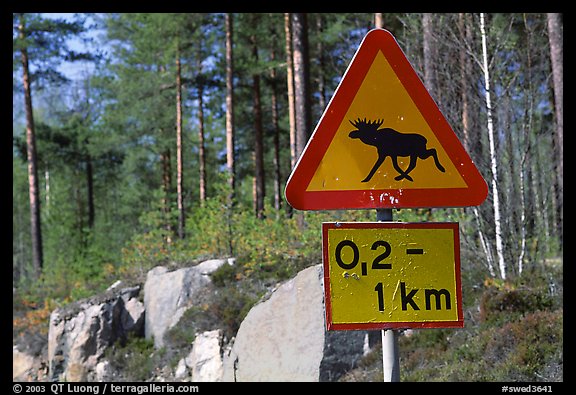Moose = 1200 pounds...
Dani+car+Moose = Equation I NEVER want to experience again.
Driving home from work with my boyfriend, it's about 10:15pm EST...all of a sudden there are big brown bodies in the road. I slam on the brakes but I am too late. Impact. I hit the second moose. She crashes into my windshield, caving it in. The moose is nice enough to leave me a present though. She drops her intestines into my lap.
Only got some cuts and scratches on my hands and arms from shielding my face on impact. My boyfriend is fine.
So, Dani's words of wisdom:
Avoid moose at all costs. Moose are not meant to be driven into. Moose will leave you presents when you gut them, accidental though it may be. And finally, the smell of moose blood and guts is nearly impossible to get out of your flesh on first scrubbing.

And now, so you understand the full impact, let me impart some moosely wisdom on you.
Life span: 15-25 years
Weight: 550-700 kg (1200-1500 lbs)
Body length: 2.5-2.7 metres
Moose are large even-toed herbivorous mammals, the largest of the deer family.
Moose vary in size and shape. Their colour varies from a little brown to a dusty black depending on the season and age of the animal. Calves, in comparison, are often a light rusty colour.
Moose have long, lighter-colored legs with the front pair longer than the hind ones. Other features include a long nose, drooping lip, hump at the shoulders and small tail. The flap of skin that hangs beneath the throat is called a BELL.
Males weigh on average over 550 kg (1200 lbs) and females often more than 400 kg (900 lbs). New born calves weigh around 15 kg but quickly increase in size, around 300 or 400 pounds by its first winter. An Alaskan moose, one of the largest sub-group, discovered in 1897 holds the record for being the largest known modern deer. It was a bull standing 2.34 metres and weighed 816kg. Its RACK (or antler spread) was 199cm.
Height at the shoulders generally ranges between 6 ½-7 ½ feet (over 2 metres).

Driving home from work with my boyfriend, it's about 10:15pm EST...all of a sudden there are big brown bodies in the road. I slam on the brakes but I am too late. Impact. I hit the second moose. She crashes into my windshield, caving it in. The moose is nice enough to leave me a present though. She drops her intestines into my lap.
Only got some cuts and scratches on my hands and arms from shielding my face on impact. My boyfriend is fine.
So, Dani's words of wisdom:
Avoid moose at all costs. Moose are not meant to be driven into. Moose will leave you presents when you gut them, accidental though it may be. And finally, the smell of moose blood and guts is nearly impossible to get out of your flesh on first scrubbing.
And now, so you understand the full impact, let me impart some moosely wisdom on you.
Life span: 15-25 years
Weight: 550-700 kg (1200-1500 lbs)
Body length: 2.5-2.7 metres
Moose are large even-toed herbivorous mammals, the largest of the deer family.
Moose vary in size and shape. Their colour varies from a little brown to a dusty black depending on the season and age of the animal. Calves, in comparison, are often a light rusty colour.
Moose have long, lighter-colored legs with the front pair longer than the hind ones. Other features include a long nose, drooping lip, hump at the shoulders and small tail. The flap of skin that hangs beneath the throat is called a BELL.
Males weigh on average over 550 kg (1200 lbs) and females often more than 400 kg (900 lbs). New born calves weigh around 15 kg but quickly increase in size, around 300 or 400 pounds by its first winter. An Alaskan moose, one of the largest sub-group, discovered in 1897 holds the record for being the largest known modern deer. It was a bull standing 2.34 metres and weighed 816kg. Its RACK (or antler spread) was 199cm.
Height at the shoulders generally ranges between 6 ½-7 ½ feet (over 2 metres).



